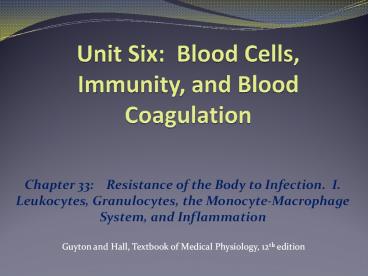Unit Six: Blood Cells, Immunity, and Blood Coagulation - PowerPoint PPT Presentation
1 / 17
Title:
Unit Six: Blood Cells, Immunity, and Blood Coagulation
Description:
Unit Six: Blood Cells, Immunity, and Blood Coagulation. Chapter 33: Resistance of the Body to Infection. I. Leukocytes, Granulocytes, the Monocyte-Macrophage System ... – PowerPoint PPT presentation
Number of Views:226
Avg rating:3.0/5.0
Title: Unit Six: Blood Cells, Immunity, and Blood Coagulation
1
Unit Six Blood Cells, Immunity, and Blood
Coagulation
- Chapter 33 Resistance of the Body to
Infection. I. Leukocytes, Granulocytes, the
Monocyte-Macrophage System, and Inflammation
Guyton and Hall, Textbook of Medical Physiology,
12th edition
2
Leukocytes (White Blood Cells)
- General Characteristics
- Types neutrophils, basophils, eosinophils,
monocytes, - lymphocytes (plasma cells)
- b. Concentrations in the blood
White Blood Cell in Whole Blood
Polymorphonuclear Neutrophils 62.0
Polymorphonuclear Eosinophils 2.3
Polymorphonuclear Basophils 0.4
Monocytes 5.3
Lymphocytes 30.0
3
Leukocytes (White Blood Cells)
- Genesis of WBCs
Fig. 33.1 Genesis of WBCs
4
Leukocytes (White Blood Cells)
- Life Span of WBCs
- Granulocytes- 4-8 hrs in the blood and 4-5 days
in tissues - Monocytes- 10-20 hrs in the blood, move into
tissues - and become macrophages which can live for months
- Lymphocytes- weeks or months moving from
circulation - into the tissues and back again
- Platelets- replaced about every 10 days (30,000
formed - per day per microliter of blood
5
Neutrophils and Macrophages Defend Against
Infections
- WBCs Enter the Tissue Spaces by Diapedsis
- WBCs Move Through the Tissues by Ameboid
Motion - WBCs Are Attracted to Inflamed Tissue by
Chemotaxis
6
Neutrophils and Macrophages (cont.)
Fig. 33.2
7
Neutrophils and Macrophages (cont.)
- Phagocytosis
- Process
- Neutrophils
- Macrophages
- Phagolysosomes
- Bactericidal properties
8
Monocyte-Macrophage Cells System
- Reticuloendothelial System (RES)
- Histiocytes
- Macrophages in the lymph nodes
- Lungs
- Kupffer cells
- Spleen and Bone Marrow
9
Fig. 33.3 Functional diagram of a lymph node
10
Fig. 33.4 Kupffer cells lining the liver
sinusoids
Fig. 33.5 Functional structures of the spleen
11
Inflammation Role of Neutrophils and Macrophages
- Inflammation
- Vasodilation of local blood vessels
- Increased permeability of the capillaries
- Clotting of fluids in the interstitial spaces
- Migration of granulocytes and monocytes
- Swelling of the tissue cells
- Chemicals released histamine, bradykinin,
- serotonin, prostaglandins, complement proteins
- activated, multiple lymphokines
12
Inflammation Role of Neutrophils and Macrophages
- Walling-Off Effect of Inflammation- delay
the - spread of bacterial or toxins
- Macrophage and Neutrophil Responses
- Neutrophil invasion of the inflammed area
- Acute increase of neutrophils in blood
- Macrophage invasion into area
- Increased production of granulocytes and
monocytes - by the bone marrow
13
Fig. 33.6 Migration of neutrophils from the
blood into the inflamed tissue
14
Inflammation (cont.)
- Feedback Control of the Macrophage/Neutrophil
- Responses
G-CSF Granulocyte Colony Stimulating
Factor GM-CSF Granulocyte-Monocyte Colony
Stimulating Factor IL-1 Inteleukin 1 M-CSF
Monocyte Colony Stimulating Factor TNF Tumor
Necrosis Factor
Fig. 33.7
15
Eosinophils
- Eosinophils
- Weakly phagocytic
- Prominent in parasitic infections
- Collect in areas where allergic reactions occur
16
Basophils
- Basophils
- Similar to mast cells
- Release heparin in the blood
- Release histamine, bradykinin, and serotonin
- IgE binds to basophil-release of histamine in
- allergic reactions
17
Leukopenia and Leukemia
- Leukopenia- bone marrow produces few wbcs
- Caused by irradiation (x-rays or gamma rays)
- Exposure to drugs and chemicals
- Leukemia- uncontrolled production of wbcs
- Types
- Effects on the body































